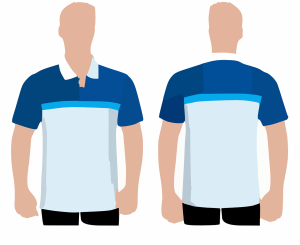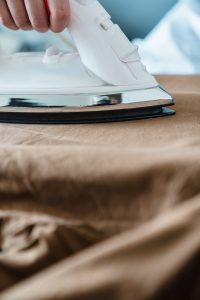40 Using Interfacing
Sheri Deaton
Using Interfacing
Importance of Interfacing

To Sew or Not to Sew… that is the Question
There are two major categories for interfacing: fusible and sew-in. When the pattern calls for interfacing, many are faced with the question: Do I use fusible interfacing or do I use sew-in interfacing?
FUSIBLE INTERFACING: For many individuals new to sewing, fusible interfacing may be the perfect addition. If the fabric you are using can be pressed with an iron, most pattern directions will call for the use of fusible interfacing. When applied correctly, fusible interfacing will be fused, or glued to, the wrong side of the fabric. It is important to note that fusible interfacing has glue on one side that is activated by the heat of the iron. In general, the fusible side is bumpy to the touch, while the non-fusible side is smooth. Placing this on the fabric the wrong way will result in the interfacing melting to the iron. Read and follow the directions, including putting the iron at the appropriate setting when using fusible interfacing.
SEW-IN INTERFACING: If the fabric you are using cannot be pressed with an iron, it is not uncommon for the pattern directions to call for the use of sew-in interfacing. This is sewn into the wrong side of the fabric. Sewing the interfacing to the fabric must be done at a specific point in the production process, so be sure to read and follow the pattern directions, never skipping over a step to “save time.”
TIP: Both fusible and sew-in interfacing will change the fabric hand or the way the fabric feels. The fabric will be stiffer after interfacing has been applied, but the degree of stiffness depends on the weight of the interfacing. Purchase a variety of weights of interfacing to allow students an opportunity to feel the difference in weights before using these in a project.

Weight… what?
Regardless of the type of interfacing used, it is important to read the pattern envelope to determine the weight of interfacing that should be used. Interfacing comes in several weights, ranging from light to heavy weight. In general, medium-weight interfacing will be an appropriate choice for many projects; however, it is important to note the suggestions provided by the pattern maker and use the suggested weight for each project.
- For more information, check out Apple Green Cottage’s (2022) article “What is interfacing in sewing–Tips for Beginners.”

Hemming it Up
Interfacing is not created equally. While lightweight interfacing may be best utilized in free-flowing garments, heavy-weight interfacing would be needed to stabilize a duffle bag. Fusible interfacing may be easier to use; however, if the fabric you are using does not allow you to press it with an iron, sew-in interfacing is the better choice. Take time to explore both types of interfacings and the various weights for each. Remember: proper implementation of this finishing touch can make or break your apparel project.
When in doubt, read and follow the directions!
Exploration of this topic will increase students’ confidence and abilities when applying interfacing. Check out the resources located at the end of this chapter. Never stop exploring!

Resources
| Resources | QR Codes |
| How to Fuse Iron-On Interfacing to Fabric |  |
| Sewing Interfacing Basics: The Ultimate Video Guide |  |
| The Basics of Interfacing |  |
| The Difference between Interfacing and Stabilizer |  |
References
Deaton, S. (2021). Teaching Apparel Production. Presentation.


